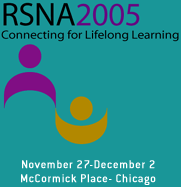
Abstract Archives of the RSNA, 2005
SSJ11-04
Peri-portal and Pancreatic Lymph Nodes as Markers of Disease Response in Patients with Hepatitis C (HCV) -related Liver Disease
Scientific Papers
Presented on November 29, 2005
Presented as part of SSJ11: Ultrasound (Liver)
Adrian K.P. Lim MD, Presenter: Nothing to Disclose
Scott Grier, Abstract Co-Author: Nothing to Disclose
Nayna Patel MS, Abstract Co-Author: Nothing to Disclose
Yu-Ting Kuo MD, Abstract Co-Author: Nothing to Disclose
Simon Taylor-Robinson MD, Abstract Co-Author: Nothing to Disclose
Martin John Blomley MD, Abstract Co-Author: Nothing to Disclose
David Owen Cosgrove MD, Abstract Co-Author: Nothing to Disclose
et al, Abstract Co-Author: Nothing to Disclose
Chronic liver disease due to hepatitis have been associated with an increased incidence of peri-portal and peri-pancreatic lymph nodes. We investigated whether their presence is related to severity of disease and if they could be used to assess response to treatment.
Abdominal ultrasounds were performed in 80 patients with biopsy-proven HCV-induced liver disease. The presence or absence of periportal and/or pancreatic lymphadenopathy was documented. Scans were performed by an experienced sonographer (NP) using a Sequoia (Acuson/Siemens) system. 50 of the 80 patients received interferon and ribavirin treatment and were scanned at 6 monthly intervals. The presence of lymph nodes were documented at follow-up scans and they were divided into responders and non-responders. Response was defined as sustained viral clearance based on serum PCR or normalisation of liver function tests.
A total of 26 patients out of the cohort of 80 had lymphadenopathy which was associated with a higher histological necroinflammatory score (5 patients with mild hepatitis, 17 with moderate/severe hepatitis and 4 with cirrhosis).
Of the 50 treated patients, 22 demonstrated lymph nodes and there were 11 responders and 11 non-responders. After treatment, 5 /11 patients in the responders group had persistent lymphadenopathy (Wilcoxon SR test: p=0.01), in contrast to 10/11 patients in the non-responders group (Wilcoxon SR test: p=0.32).
33% of patients with HCV-related liver disease in our cohort demonstrate the presence of periportal and/or pancreatic lymphadenopathy. This may have prognostic importance, in suggesting more advanced disease. Conversely, they are more likely to regress in patients who respond to interferon and ribavirin treatment and may thus be helpful non-invasive markers of response to disease.
Lim, A,
Grier, S,
Patel, N,
Kuo, Y,
Taylor-Robinson, S,
Blomley, M,
Cosgrove, D,
et al, ,
Peri-portal and Pancreatic Lymph Nodes as Markers of Disease Response in Patients with Hepatitis C (HCV) -related Liver Disease. Radiological Society of North America 2005 Scientific Assembly and Annual Meeting, November 27 - December 2, 2005 ,Chicago IL.
http://archive.rsna.org/2005/4411995.html

